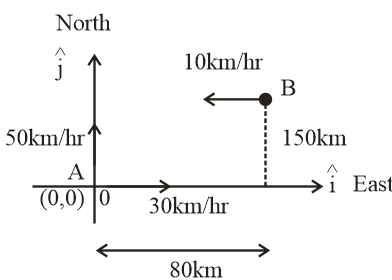Answer
429k+ views
Hint: We know that the relation between time, velocity and displacement is given as
Time $ = \dfrac{{displacement}}{{velocity}}$
And the above expression is also applicable for relative motion like relative velocity, relative displacement etc. But time does not depend on frame of reference.
Complete step by step answer:

Given that initial positions of ship A & B is
${\vec r_A} = 0\hat i + 0\hat j$ …..(1)
${\vec r_B} = (80\hat i + 150\hat j)km$ ….(2)
So, the relative position of B with respect to A
${\vec r_{BA}} = (80\hat i + 150\hat j)km$ …..(3)
Also, given that the velocity of ship A & B is
${\vec v_A} = (30\hat i + 50\hat j)km/hr$
${\vec v_B} = - 10\hat ikm/hr$
So, relative velocity of B with respect to A is
${\vec v_{BA}} = - 10\hat i - (30\hat i + 50\hat j)$
$ = - 10\hat i - 30\hat i - 50\hat j$
${\vec v_{BA}} = - 40\hat i - 60\hat j$ …..(4)
And magnitude of ${\vec v_{AB}}$ is given as
\[|{\vec v_{BA}}| = \sqrt {{{(40)}^2} + {{(50)}^2}} \]
$\sqrt {1600 + 2500} $
$|{\vec v_{BA}}| = \sqrt {4100} $ …..(5)
We know that
Time t $ = \dfrac{{displacement(\vec r)}}{{velocity(\vec v)}}$
In relative motion
$t = \dfrac{{{{\vec r}_{BA}}}}{{{{\vec v}_{BA}}}}$
On multiplying ${\vec v_{BA}} \Rightarrow t = \dfrac{{{{\vec r}_{BA}} \cdot {{\vec v}_{BA}}}}{{{{\vec v}_{BA}} \cdot {{\vec v}_{BA}}}}$
$t = \dfrac{{{{\vec r}_{BA}} \cdot {{\vec v}_{BA}}}}{{|{{\vec v}_{BA}}{|^2}}}$
So, from equation 3, 4 & 5
$t = \dfrac{{(80\hat i + 150\hat j) \cdot ( - 40\hat i - 50\hat j)}}{{{{(\sqrt {4100} )}^2}}}$
$t = \dfrac{{[ - (80 \times 40)] + [ - (150 \times 50)]}}{{4100}}$
$t = \dfrac{{ - 3200 - 7500}}{{4100}} = \dfrac{{ - 10700}}{{4100}}$
Time never be –ve, hence
$t = \dfrac{{10700}}{{4100}} = \dfrac{{107}}{{41}} = 2.6$ hours
$t = 2.6$ hours
So, the correct answer is “Option D”.
Note:
Relative motion is a concept which makes numerical problems easy. We can apply the above formulae only when there is no acceleration given to particles. Time does not depend on frame of reference.
Time $ = \dfrac{{displacement}}{{velocity}}$
And the above expression is also applicable for relative motion like relative velocity, relative displacement etc. But time does not depend on frame of reference.
Complete step by step answer:

Given that initial positions of ship A & B is
${\vec r_A} = 0\hat i + 0\hat j$ …..(1)
${\vec r_B} = (80\hat i + 150\hat j)km$ ….(2)
So, the relative position of B with respect to A
${\vec r_{BA}} = (80\hat i + 150\hat j)km$ …..(3)
Also, given that the velocity of ship A & B is
${\vec v_A} = (30\hat i + 50\hat j)km/hr$
${\vec v_B} = - 10\hat ikm/hr$
So, relative velocity of B with respect to A is
${\vec v_{BA}} = - 10\hat i - (30\hat i + 50\hat j)$
$ = - 10\hat i - 30\hat i - 50\hat j$
${\vec v_{BA}} = - 40\hat i - 60\hat j$ …..(4)
And magnitude of ${\vec v_{AB}}$ is given as
\[|{\vec v_{BA}}| = \sqrt {{{(40)}^2} + {{(50)}^2}} \]
$\sqrt {1600 + 2500} $
$|{\vec v_{BA}}| = \sqrt {4100} $ …..(5)
We know that
Time t $ = \dfrac{{displacement(\vec r)}}{{velocity(\vec v)}}$
In relative motion
$t = \dfrac{{{{\vec r}_{BA}}}}{{{{\vec v}_{BA}}}}$
On multiplying ${\vec v_{BA}} \Rightarrow t = \dfrac{{{{\vec r}_{BA}} \cdot {{\vec v}_{BA}}}}{{{{\vec v}_{BA}} \cdot {{\vec v}_{BA}}}}$
$t = \dfrac{{{{\vec r}_{BA}} \cdot {{\vec v}_{BA}}}}{{|{{\vec v}_{BA}}{|^2}}}$
So, from equation 3, 4 & 5
$t = \dfrac{{(80\hat i + 150\hat j) \cdot ( - 40\hat i - 50\hat j)}}{{{{(\sqrt {4100} )}^2}}}$
$t = \dfrac{{[ - (80 \times 40)] + [ - (150 \times 50)]}}{{4100}}$
$t = \dfrac{{ - 3200 - 7500}}{{4100}} = \dfrac{{ - 10700}}{{4100}}$
Time never be –ve, hence
$t = \dfrac{{10700}}{{4100}} = \dfrac{{107}}{{41}} = 2.6$ hours
$t = 2.6$ hours
So, the correct answer is “Option D”.
Note:
Relative motion is a concept which makes numerical problems easy. We can apply the above formulae only when there is no acceleration given to particles. Time does not depend on frame of reference.
Recently Updated Pages
Mark and label the given geoinformation on the outline class 11 social science CBSE

When people say No pun intended what does that mea class 8 english CBSE

Name the states which share their boundary with Indias class 9 social science CBSE

Give an account of the Northern Plains of India class 9 social science CBSE

Change the following sentences into negative and interrogative class 10 english CBSE

Advantages and disadvantages of science

Trending doubts
Difference between Prokaryotic cell and Eukaryotic class 11 biology CBSE

Which are the Top 10 Largest Countries of the World?

Fill the blanks with the suitable prepositions 1 The class 9 english CBSE

Differentiate between homogeneous and heterogeneous class 12 chemistry CBSE

Difference Between Plant Cell and Animal Cell

10 examples of evaporation in daily life with explanations

Give 10 examples for herbs , shrubs , climbers , creepers

Write a letter to the principal requesting him to grant class 10 english CBSE

How do you graph the function fx 4x class 9 maths CBSE



